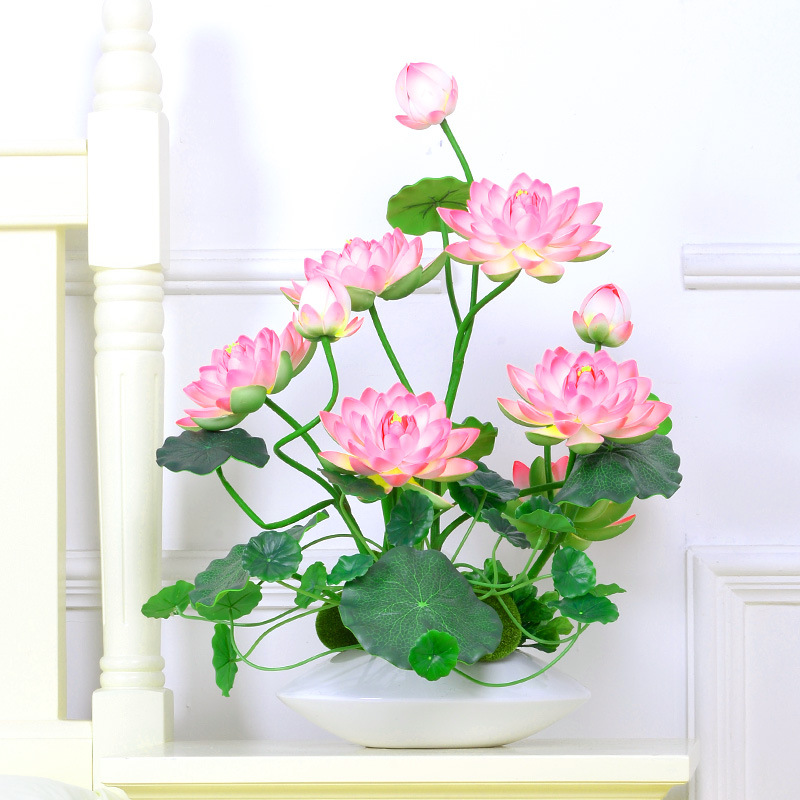🌸 Product Advantages
Artificial lotus flowers are prized for their symbolic meaning and wide decorative use. Partnering with an experienced artificial lotus manufacturer ensures key advantages:
-
🌟 Cultural Elegance – Symbolic design that reflects purity and tradition.
-
🛡 Durability – Made from silk and polyester to maintain color and form over time.
-
📦 Wholesale-Ready – Cost-effective pricing supports bulk and mixed carton orders.
-
🎀 Versatile Applications – Ideal for weddings, hotels, temples, spas, and décor projects.
-
🎁 Custom Options – Tailored sizes, colors, and packaging for specific buyer needs.
🎨 Customization Services
As a custom artificial lotus supplier, we help buyers create unique collections that stand out:
-
🎯 Colors: Pantone-matched shades, from traditional pink and white to modern color palettes.
-
✂️ Sizes & Stems: Available in compact tabletop sizes or large stems for displays.
-
🏷 Packaging Solutions: Branded gift boxes, logo tags, and retail-ready wrapping.
-
💐 Floral Collections: Lotus paired with orchids, magnolias, or roses for premium assortments.
For curated designs, visit our Artificial Magnolia Manufacturers section, where magnolias and lotuses are often used together for luxury projects.
🧵 Materials & Structure
The realism of artificial lotus flowers comes from premium materials and expert craftsmanship. Our artificial lotus factory ensures:
-
🌸 Petals: High-quality silk, polyester, or PU fabrics provide natural softness and vivid colors.
-
🌿 Stems: Wire or reinforced plastic for strength and flexibility.
-
🎨 Color Techniques: Spray-dyeing, gradient printing, and hand-painted details.
-
🪡 Assembly: Skilled hand-finishing delivers authentic lotus blossoms for wholesale markets.
This guarantees consistent quality across all global shipments.
📊 Minimum Order Quantity (MOQ)
We provide flexible MOQ policies to meet various buyer needs:
-
📦 Trial Orders: Low MOQ for first-time buyers to test quality.
-
🔄 Mixed Cartons: Lotus flowers can be combined with other artificial flowers.
-
📈 Large Capacity: Bulk production for international distributors and seasonal demand.
This flexibility makes sourcing artificial lotus simple and cost-effective.
⭐ Why Choose Us
Partnering with a trusted artificial lotus supplier ensures long-term reliability and strong business growth:
-
🏭 Factory-Direct Production: In-house design, sampling, and bulk manufacturing.
-
🛡 Quality Control: Multi-stage QC ensures international standard compliance.
-
🌍 Export Expertise: Professional packing and logistics support global buyers.
-
💡 Custom & Wholesale: Capable of handling both bulk and personalized projects.
-
🤝 Reliable Partnership: Transparent pricing and dedicated communication.
Explore more options in our Artificial Flowers Wholesale section, where lotus collections complement other popular flowers.
💬 FAQs
Q1: Can I request lotus flowers in custom colors?
Yes. We produce custom artificial lotus in Pantone shades with branded packaging.
Q2: What is your MOQ for artificial lotus?
Our MOQ is flexible, allowing both small trial orders and bulk wholesale supply.
Q3: How do you ensure consistent product quality?
We apply strict QC at every stage, from raw materials to packaging and shipping.
Q4: Do you offer eco-friendly options?
Yes. Sustainable fabrics and recyclable packaging are available upon request.
🌺 Conclusion
Artificial lotus flowers combine elegance, symbolism, and versatility, making them popular for weddings, retail, hotels, and décor projects. By working with a professional artificial lotus manufacturer and supplier, buyers secure factory-direct pricing, flexible MOQ, and complete customization services. Our factory ensures quality through advanced materials, skilled craftsmanship, and strict QC systems. Whether for trial batches or large wholesale orders, our artificial lotus flowers deliver both beauty and reliable supply, helping global buyers achieve long-term success.



